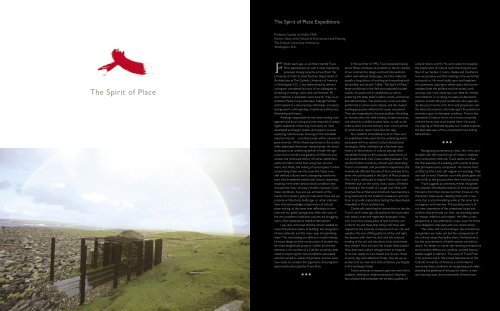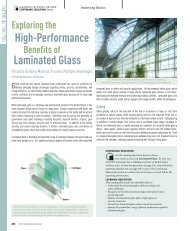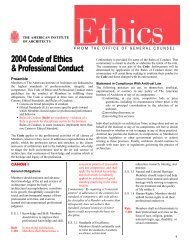Download this PDF - Architectural Record
Download this PDF - Architectural Record
Download this PDF - Architectural Record
Create successful ePaper yourself
Turn your PDF publications into a flip-book with our unique Google optimized e-Paper software.
The Spirit of Place Expeditions<br />
Professor Stanley Ira Hallet, FAIA<br />
Former Dean of the School of Architecture and Planning<br />
The Catholic University of America<br />
Washington, D.C.<br />
The Spirit of Place<br />
Fifteen years ago, an architect named Travis<br />
Price approached me with a most interesting<br />
proposal. Having recently arrived from the<br />
University of Utah to head the then Department of<br />
Architecture at The Catholic University of America<br />
in Washington, D.C., I was determined to redirect<br />
a program considered by many of my colleagues to<br />
be lacking in energy, vision and commitment. My<br />
own interests in education were diverse: I had, as an<br />
architect, Peace Corps Volunteer, Fulbright Scholar<br />
and husband to a documentary filmmaker, an eclectic<br />
background in anthropology, traditional architecture,<br />
filmmaking and theory.<br />
Although responsible for the never-ending management<br />
and fund-raising activities required of today’s<br />
higher academies of learning, from early on I also<br />
developed and taught studios and support courses<br />
exploring cultural issues, focusing on the inevitable<br />
need to interven e architecturally within cultures of<br />
great diversity. Within these explorations, the studios<br />
often addressed three over-riding themes: the found<br />
landscape as an underlying definer of both the agricultural<br />
environment and gardens of reflection and<br />
retreat, the continued history of human settlement<br />
within the fabric of the built and grown environment,<br />
and, finally, the making of sacred space. Further<br />
complicating these was the issue that these once<br />
well defined cultures were undergoing transformations<br />
that threatened traditionally historic responses,<br />
resulting in the often dysfunctional conditions that<br />
characterize many of today’s modern habitats. Given<br />
these conditions, how are we, architects of the<br />
twenty-first century, going to intervene How will we<br />
propose architectural, landscape, or urban interventions<br />
that acknowledge a long history of cultural<br />
place-making, at the same time reflecting our own<br />
time and our global perspective, often the roots of<br />
the very problems traditional cultures are struggling<br />
with in their attempts to redefine themselves<br />
I was also convinced that the school needed to<br />
revisit the physical reality of building, the recognition<br />
of new materials, and the many ways of assembling<br />
them. This was leading our efforts in model making,<br />
furniture design and the construction of modest but<br />
full-scale design/build projects. Gather all of these<br />
interests in the context of a Catholic university dedicated<br />
to exploring the moral problems associated<br />
with the sacred as well as the profane, and we were<br />
now ready to consider the arguments and programs<br />
passionately advocated by Travis Price.<br />
❖ ❖ ❖<br />
In the summer of 1992, Travis proposed taking<br />
ten to fifteen architecture students to the far reaches<br />
of our continent to design and build interventions<br />
within well-defined landscapes, sites that reflected<br />
equally a long history of working and reworking both<br />
the profane and sacred. Called “The Spirit of Place,”<br />
these workshops in the field encompassed focused<br />
studies of a place and its inhabitants as well as<br />
exploring the deep belief systems, myths, and stories<br />
that defined them. The preliminary cultural studies<br />
performed in school were intense, and the student<br />
building proposals reflected the issues uncovered.<br />
They also responded to the practicalities of building<br />
on remote sites with little funding, limited resources,<br />
and relatively unskilled student labor, as well as the<br />
need to erect the interventions over a short period<br />
of construction, never more than ten days.<br />
Our students immediately took to Travis and<br />
his unabashed enthusiasm for the underlying myths<br />
associated with our planet’s cultural and physical<br />
landscapes. What unfolded was a fourteen-year<br />
history of interventions in cultural settings often<br />
completely foreign to the quotidian experiences of<br />
our predominantly East Coast undergraduates. The<br />
results formed a continuity of built work illustrating<br />
Travis’s core beliefs, and provided an experience that<br />
dramatically affected the lives of the hundreds of students<br />
who participated in the Spirit of Place projects.<br />
This, in turn, continued to inspire Travis’s own work.<br />
Whether built on the windy, rocky coasts of Ireland<br />
or floating in the middle of a jungle river filled with<br />
piranhas, the architectural constructs have become a<br />
living testament to the students’ endeavors, and continue<br />
to provide a laboratory testing the ideas deeply<br />
imbedded in Price’s architecture.<br />
Continually searching for connections to the site,<br />
Travis’s work raises age-old questions still associated<br />
with today’s tired and neglected landscapes. How<br />
will I sit on <strong>this</strong> unique piece of land and how will<br />
it inform me and those that follow me How will I<br />
respond to the constant companions of sun, rain and<br />
weather, the ever shifting patterns of day and night,<br />
the seasons with their hot and cold, the constant<br />
eroding of the soil and the plants, birds and animals<br />
they shelter How did man first inhabit these places<br />
How does each culture reshape them to respond<br />
to its own needs, its own beliefs and its own rituals<br />
of work, play and reflection Finally, how do we, as<br />
products of our own time and conditions, participate<br />
in <strong>this</strong> landscape today<br />
Travis continues to expand upon the work of his<br />
students, seeking an understanding and interpretation<br />
of place that embodies the timeless qualities of<br />
cultural history and fit. His work seeks to recognize<br />
the importance of cultural myth informing the very<br />
fiber of our bodies: it colors, shades and transforms<br />
how we perceive and find meaning in the world that<br />
surrounds us. His work builds upon and heightens<br />
<strong>this</strong> awareness, aspiring to define space that accommodates<br />
both the profane and the sacred, work<br />
and play, and, most important, our need for retreat<br />
and reflection. In so doing, he seeks an alternative<br />
position to both the post-modernists who appropriate<br />
the past in terms of its form and proportion and<br />
the deconstructionists who take apart the present to<br />
comment upon its dystopian condition. Travis is less<br />
interested in historic forms; he is more concerned<br />
with the forces that once shaped them. He avoids<br />
the copying of inherited façades, but instead explores<br />
the dark alleyways of the unresolved forces lurking<br />
behind them.<br />
❖ ❖ ❖<br />
Recognizing contemporary facts, he is very comfortable<br />
with the inventive use of modern materials<br />
and construction methods. Travis seems to infuse<br />
the final assembly of a building with a sense of place<br />
that permeates every component. He marries hard<br />
architectural fact with soft vegetal surroundings. Tree<br />
and wall co-exist. Materials rust while plants grow tall,<br />
only to fall to the ground when their time has come.<br />
Travis suggests an architecture that recognizes<br />
the complex interrelated histories of time and place.<br />
He learns from their stories, but then moves on. He<br />
champions these issues, retelling them with a new<br />
voice that is accommodating while at the same time<br />
courageous and inventive. The resulting work is of<br />
our time, expressive of the unresolved issues and<br />
conflicts that dominate our lives, yet providing space<br />
for repose, refection and respect. He offers a new<br />
perspective, a new alternative, a new vision for those<br />
of us obliged to intervene with our constructions.<br />
The urban and rural landscape, the architecture<br />
and gardens we make, are but the consequences of<br />
the cultural values that define them. Architecture is<br />
but the concretization of belief systems we hold so<br />
dearly. For better or worse, the resulting architectural<br />
environment reflects our condition and the historic<br />
battles waged to define it. The work of Travis Price<br />
in his practice and in the unique laboratories at The<br />
Catholic University of America is committed to<br />
improving these conditions by recognizing and understanding<br />
the potential of the past to inform, in new<br />
and inspiring ways, the environment of tomorrow.<br />
151<br />
AOTlayout_part2_gatefolds.indd 150-151<br />
8/10/06 4:12:21 PM
SUKHAVATI AND THE NAGAS…<br />
NEPAL, THE NAGA SHRINE<br />
My office was commissioned to design a large<br />
project in Nepal a few years back, an Ayurvedic<br />
yoga retreat. Half the owners were totally ready to<br />
embrace the philosophy of metaphorical modern industrialism;<br />
the other half still wanted the nostalgic<br />
past reproduced. The debate was so crucial that the<br />
mayor of Kathmandu convened his entire planning<br />
staff to discuss our one project as a vision for the<br />
sacred city’s growth aesthetic.<br />
Half of the investors came from a nostalgic, ex<br />
pat world, there to escape the industrial world and<br />
wanted to live in literal remakes of Nepali villages,<br />
but with electricity and toilets, cell phones, six servants<br />
and of course never-ending instant chai. They<br />
faced the classic question for any Eco resort today:<br />
how do we keep an authentic spirit but introduce<br />
high tech advantages Eco resorts, because they’re<br />
pricey, can afford to ask these questions. Why can’t<br />
that be the format for built environments everywhere<br />
You can live ecologically within a cool, hip,<br />
modern architecture that has different flavors and<br />
different sights and different cultures, all within a<br />
subdivision. The answer, we hear constantly, is that<br />
nobody has enough money and enough vision to<br />
take the risk to build them. The money is really the<br />
same, it’s the vision that’s missing.<br />
I took on a “Spirit of Place” expedition in Nepal<br />
in conjunction with designing the larger project.<br />
The site was at the base of Nagarjun Mountain; the<br />
theme was to design a meditation shrine dedicated<br />
to the Sukhavati (Place of Bliss ) & the Naga (Snakes<br />
of Knowledge).<br />
In nine days, we built a cantilevered platform<br />
over a hundred-foot drop, stretching out above a<br />
sea of cobras, leeches and nagas, where one could<br />
sublimely sit on a glass mandala held by a single<br />
steel beam. It wiggled as you stepped out and<br />
vibrated slowly as you sat down, finally diminishing<br />
its shaking as your own fears subsided and the inner<br />
voyage began.<br />
160<br />
161<br />
Above: Nepalis, Newaris, ex-pats, students, and teachers.<br />
Photograph by Chris Rainier. Opposite: Meditation over<br />
100-foot cliff on glass floor—Nagajune Mountain beyond.<br />
Photograph by Chris Rainier.<br />
EXPEDITIONS THROUGH THE THREE LENSES<br />
AOTlayout_part2_gatefolds.indd 160-161<br />
8/10/06 4:13:05 PM
BELMULLET<br />
158<br />
WIDENING THE THIN PLACE…<br />
During the design-and-build course for “Spirit of<br />
Place,” a simultaneous design studio project was<br />
also undertaken for a library and community center<br />
to be located in the village of Belmullet, County<br />
Mayo, again on the western coast of Ireland. The<br />
site is on a narrow canal, which splits off a large<br />
peninsula from Erris and the mainland. It is both a<br />
major demarcation and genus loci of the area, as<br />
well as a natural thin place. How to take the lyric<br />
of a single object in the landscape and make whole<br />
buildings was the heart of <strong>this</strong> project and the intent<br />
of the studio.<br />
One idea was to have the one building become<br />
two buildings on each side of the banks using curved<br />
glass facing each other. Each face is out over the<br />
river so that people in two opposite buildings are<br />
looking at each other, and the glass is cantilevered<br />
perhaps only a few feet apart. They could signal to<br />
each other but not touch. The two buildings then<br />
curve away. Just to have that moment in the public<br />
hallway on both sides, to have people walking back<br />
and forth and not being able to do anything other<br />
than communicate with body language, was a playful<br />
gesture about a thin place.<br />
Another design used a series of buildings in a<br />
running parallel formation broken into a series of<br />
functions: the library, the reading stacks, the reception<br />
area. Buildings where bridges—and stripes<br />
of thin places—run parallel to each other, parallel<br />
infinities divided by function.<br />
Another design idea was a series of undulating<br />
copper green tents reflecting on a single top as a<br />
moment of time constantly changing its position, as<br />
nature does. The concept was that as you moved<br />
along the buildings, the pinnacle point for each one<br />
changed its location so that you saw time marching<br />
along linearly, but at the same time, when you<br />
put them all together, you got a sense of time going<br />
back and forth. Aside from an image of undulating<br />
bogs, the design puts you into the thin place with its<br />
rhythmic, seesawing effect.<br />
All of these wonderful designs, simultaneously<br />
designed as a future 100,000-square-foot environmental<br />
center inspired by the “Thin Places,” prove<br />
unequivocally that large-scale modern architecture<br />
designed with the three lenses could simultaneously<br />
come from the landscape and capture the mythic.<br />
Top left: Model by Kimberly Johnson. Time depicted by<br />
changing moments or pinnacle peaks. Top right: Model by<br />
Natali Lomeli. Parallel buildings separated by thin places.<br />
Middle left: Model by Kimberly Johnson. Moving bog tents<br />
of copper in field of wind machines. Middle right: Sculpture<br />
model by Deborah Lerner. Rings of time moving forward<br />
and backward simultaneously. Left: Model by Natali Lomeli.<br />
Endless lines to infinity of time interrupted by hushed<br />
whispers. All photographs by Travis Price.<br />
159<br />
EXPEDITIONS THROUGH THE THREE LENSES<br />
AOTlayout_part2_gatefolds.indd 158-159<br />
8/10/06 4:12:55 PM
THE THIN PLACES: DOONAMOE<br />
Simultaneously that year, we built another project.<br />
It too was a “t’in place,” the big brother of Anagh<br />
Head. The site was a large blowhole in the ground<br />
where the sea has eaten the land from underneath,<br />
about 100 feet below the surface. The sea<br />
had been continuously bashing the rock cliffs for<br />
many hundreds of centuries. It bored under the<br />
rocks and shot straight up, blowing a hole through<br />
the solid granite land mass. When the gale winds<br />
are coming and the 200 foot waves are hitting, it<br />
shoots a spout, like a whale’s, hundreds of feet up<br />
into the air.<br />
The astonishing magic of these two enormous<br />
projects—besides their mystical impact—<br />
was that we actually built them simultaneously<br />
in nine days flat-out. At Anagh Head, the land is<br />
pushing into the sea and at Doonamoe the sea is<br />
pushing into the land. You can see them one from<br />
another, four miles apart along the coast. The seesaw<br />
effect of land-eating-sea and sea-eating-land<br />
when viewed simultaneously was to experience<br />
the paradoxical nature of the thin places—extraordinarily<br />
magnified!<br />
We could just barely see each other working<br />
on a clear day. I was zooming back and forth with<br />
three cell phones, twenty-five students, twenty<br />
Irishmen, often getting lost in thick foggy patches.<br />
Hats off to the students and the local Irish<br />
craftsmen: they all did amazing things. Hats<br />
off to the philosophy they experienced during<br />
these grueling expeditions, in concert with their<br />
personal interpretations of Stillness, Movement<br />
and Nature: the structures have had an enormous<br />
impact on the local people, myself, the students<br />
and the quest for the Mythic Modernist language<br />
of architecture.<br />
156<br />
157<br />
Previous spread: Rainbow over beehive exploding to the<br />
sea at Anagh Head, Ireland. Photograph by Chris Rainier.<br />
Top: View from above of student model. Photograph<br />
by Travis Price. Above: Sunrise view with <strong>this</strong>tle of steel<br />
greeting wisps of clouds. Photograph by Chris Rainier.<br />
Opposite: 110-foot waves crashing against cliff edge;<br />
Equinox axis path to steel cage above the blowhole.<br />
Photograph by Eamon O’Boyle.<br />
EXPEDITIONS THROUGH THE THREE LENSES<br />
AOTlayout_part2_gatefolds.indd 156-157<br />
8/10/06 4:12:52 PM
THE THIN PLACES: ANAGH HEAD<br />
154<br />
One Spirit of Place student project, our ninth, was<br />
in Ireland, a stunning example of going to a site,<br />
looking at powerful environmental forces, being<br />
overwhelmed with a living metaphor and producing<br />
uncanny results in just nine non-stop days of<br />
rain-soaked construction. We built two projects<br />
simultaneously on the west coast, where the Irish<br />
are still absolutely mad. The rational world is always<br />
secondary there to the realms of poetry and living<br />
myths. Nearby is Yeats’ Donegal, Sligo and the<br />
magic of Galway. This is where Yeats and Joyce<br />
would retreat to from Dublin to find their inspiration;<br />
Crough Patrick pilgrimage mountain beckons<br />
nearby. This is where Patrick married the worship<br />
of the sun with the Son. This is where the poets<br />
escaped to, to find the deeper mythic soul of their<br />
Gaelic blood.<br />
One theme kept coming up as I walked around<br />
asking people about mystical lore. Of course every<br />
rock there has about ten tales attached to it so I<br />
got a bellyful and then some. The Irish are greatly<br />
beloved fibbers with endless exaggeration, and<br />
because they’re great liars they’re great storytellers,<br />
which in turn makes them phenomenal writers.<br />
They love to twist and turn, not to evade, but<br />
actually to delve into more complex meaning. They<br />
dance with the truth. So what seems like a contradiction<br />
or lies isn’t really so; it’s actually another way<br />
of seeing things. It’s where being in a paradoxical<br />
state is the norm. Such a view of reality exists in the<br />
landscape and the mind. In the landscape, such real<br />
locations are often referred to as the “thin places.”<br />
After hearing from many locals, I asked Seamus<br />
Caulfield, Ireland’s premier archeologist, “What is a<br />
thin place” In the pub, several people’s eyes lit up.<br />
He smiled, his eyes mystified and mischievous all at<br />
once. “Ah, the t’in places; I’ve encountered them.”<br />
(“T’in” with no “h” is the Irish pronunciation.) In<br />
Irish life they are the places where time past, future,<br />
and present merge. If you read a lot of poetry and<br />
mysticism from Rumi to T. S. Eliot, you hear tell of<br />
it—time past is part of time future, and time future<br />
is time past, and time now is encompassing all. The<br />
thin places are real places in the landscape, a matrix<br />
of moments where people find themselves falling<br />
into timelessness or eternity, the world of the<br />
greater mind, the Pleroma, the living collective unconscious;<br />
the world where things outlive the physical.<br />
That’s where the fairies and the banshees and<br />
the leprechauns and the gods all live; however, it’s<br />
not a simple metaphysical suburb. To actually come<br />
upon a vortex in the landscape that can physically<br />
make that happen was exciting to no end. I spent<br />
a whole week traipsing up and down County Mayo<br />
to find a site that felt like that. Lost in the bog and<br />
rain, it seemed hopeless until Anne and Lawrence<br />
Howard—sheep farmers, sculpture aficionados,<br />
and enduring friends—steered me to a remote<br />
peninsula towards sunset one day. Anagh Head, an<br />
exotic rock peninsula, had me in one instant; I knew<br />
it. My legs turned to Jell-O. Something was going on<br />
there. I didn’t know what it was, but I was at ease in<br />
a thin place at last. The same feeling occurred a few<br />
miles away and a few days later at Doonamoe, an<br />
enormous blowhole.<br />
These two design-build expeditions involved<br />
choosing twenty-five students. For a semester we<br />
explored what a thin place is and how could it be<br />
expressed in architectural form—other than two<br />
thin walls that one can’t get through. Then, for two<br />
weeks, we went to the coast of Ireland and actually<br />
built them both simultaneously! We explored the<br />
landscape, and began to realize that where the moss<br />
actually stops growing, where the bog and the rocks<br />
touch, there’s a thing called the Tír Sáile—where<br />
the earth and the salted air meet; in Gaelic, Tír<br />
being the earth, and Sáile being the salted air. Salty<br />
air kills organic matter such as coastal moss; the<br />
moss then dies and new moss grows on top of the<br />
dead on and on for centuries, thus creating a bog,<br />
a bouncy covering two to ten feet thick. It has<br />
covered entire villages, such as the Ceide Fields, for<br />
over 5,500 years. Seamus calls it a slow-motion lava.<br />
Anagh Head is a huge landmass, where the rock<br />
is actually a rocky prow tearing into the ocean,<br />
fighting it constantly. The sea coughs stones and<br />
boulders hundreds of feet in the air back at the<br />
land. So you know you’re not going to build in the<br />
range of fire of the boulders, but right at the line<br />
where the storms can’t reach, right where the rocks<br />
end and the bog begins: there is a thin place. The<br />
wave mass coming from the ocean is two hundred<br />
feet deep. The island of Ireland is thick at the edge.<br />
Deep in nature, booming in your subconscious, you<br />
find the magical thin place of eons of rocking sea<br />
against rock.<br />
On the Anagh Head site we built a hemi-beehive,<br />
a classic way of creating a monk’s retreat in<br />
stone, and then we exploded out to the sea with<br />
accelerating steel arches amplifying the moment you<br />
walked into that little thin place. You are at once<br />
centered and catapulted by the sea’s edge.<br />
The day I got there to explore for sites (a year<br />
before we built the projects), tragically, two local<br />
children drowned at sea. My children were with me,<br />
which amplified the sadness even more. The next<br />
year, when we were building the project, those children’s<br />
families all came along with everybody else<br />
to celebrate its completion. It was an overwhelming<br />
moment of sadness and release. The spirit of the<br />
architecture resonated again. Father Kevin, more<br />
a mystical-environmental Gandalf than a priest,<br />
dedicated the project to those lost at sea.<br />
People came from all over; they came to stand<br />
at a sanctuary outside their churches. For some<br />
it was exhilarating to see the celebrations of the<br />
sea, for others who had lost loved ones, it was a<br />
sad remembrance: the landscape is so much a state<br />
of mind. In combination, sadness and joy shared<br />
a mystical resonance with the sea and the land; a<br />
thin place enveloped them. Sitting there, you engulf<br />
the great sea, submitting to a wondrous sense of<br />
rest and resolution. The back-and-forth motion of<br />
the tides erases time’s slow acceleration into the<br />
eternal rocks.<br />
Top: Travis Price in County Mayo with Peter Hynes,<br />
Architect—Key Maestro for Spirit of Place in Ireland. Photograph<br />
by Jose Benitez. Above: Approaching the Anagh Head<br />
Spirit of Place—The thin place between steel and stone<br />
bog. Photograph by Travis Price. Opposite: 110-foot gorge<br />
at Doonamoe looking over the Irish Sea toward Boston.<br />
Photograph by Kenneth M. Wyner.<br />
“THE EARLY CELTS BELIEVED IN ‘THIN PLACES’: GEOGRAPHICAL LOCATIONS SCATTERED<br />
THROUGHOUT IRELAND AND THE BRITISH ISLES WHERE A PERSON EXPERIENCES ONLY A<br />
VERY THIN DIVIDE BETWEEN PAST, PRESENT, AND FUTURE TIMES; PLACES WHERE A PERSON IS<br />
SOMEHOW ABLE, POSSIBLY ONLY FOR A MOMENT, TO ENCOUNTER A MORE ANCIENT REALITY<br />
WITHIN PRESENT TIME; OR PLACES WHERE PERHAPS ONLY IN A GLANCE WE ARE SOMEHOW<br />
TRANSPORTED INTO THE FUTURE. SOME OF THE STORIES HERE THAT ASSOCIATE THE SAINTS<br />
WITH INTUITIVE AND PSYCHIC POWERS ATTEST TO THESE ‘THIN PLACES.’”<br />
—EDWARD SELLNER, WISDOM OF THE CELTIC SAINTS<br />
155<br />
EXPEDITIONS THROUGH THE THREE LENSES<br />
AOTlayout_part2_gatefolds.indd 154-155<br />
8/10/06 4:12:39 PM
152<br />
Epiphany at Lake Ealue:<br />
the Spirit of Place<br />
A<br />
spiritual watershed for me in my professional<br />
and academic life was an epiphany<br />
that came at Lake Ealue in northern British<br />
Columbia, about sixteen years ago. It ultimately<br />
led to the development of a series of design/build<br />
expeditions, thirteen thus far, titled the “Spirit of<br />
Place.” In them I found clarity for the final lens,<br />
Stillness, and coalesced my greater search for the<br />
Mythic Modern.<br />
It was then that I met a genius who has since<br />
become one of my best friends and mentors, Wade<br />
Davis, an anthropologist, writer, and the Explorerin-Residence<br />
at the National Geographic Society.<br />
I had known his wife, Gail Percy, for years. One<br />
evening Wade and I shared dinner at a Japanese<br />
modernist house I had designed in Georgetown<br />
for Catherine Mellon. We talked almost until dawn<br />
about anthropology, mysticism, architecture and the<br />
mysteries of cultures. He said, “You’ve got to come<br />
up and visit my spiritual lair at Lake Ealue so we can<br />
continue <strong>this</strong> rap. Bring your children as well.” I did.<br />
It changed my life.<br />
Getting there is in itself no simple expedition.<br />
Lake Ealue is about 1,200 miles north of Vancouver,<br />
four or five days up a long logging road. The first<br />
time I went—with my children—we went halfway<br />
by plane, flying over a thousand glaciers or so,<br />
landed, took the luggage out of the aisle with the<br />
pilot helping us, got the only rental vehicle in the<br />
last township before Ealue and headed north 300<br />
more miles. On the drive, I lost a windshield and a<br />
gas tank from rocks; after patching the tank with<br />
liquid filler and filling it up at a gas station for logging<br />
trucks, we arrived by the skin of our teeth at the<br />
middle of nowhere, just short of the Yukon border.<br />
Our first human contact was when Wade<br />
introduced us to Alec Jack, a 98 year old Indian<br />
chief, and his wife, who was 102. He had not seen a<br />
non nomadic person until he was 25. Being around<br />
Wade and Jack was like living in a whole other,<br />
mythological world; to be immersed with ecumenically<br />
minded mates in the wilderness was manna<br />
from heaven. Wade serves it up in quantum gulps.<br />
Up at Ealue, the connections between modern architecture,<br />
nature, and mythology looped back into<br />
my worldview as if being in New Mexico pueblos<br />
fifteen years ago was only fifteen minutes away.<br />
Wade and I became great buddies, because we both<br />
really enjoyed making things, cutting firewood, hiking<br />
and camping, and at the same time having voracious<br />
intellectual discussions about the mythological<br />
world. Wade loved building, but hadn’t delved much<br />
into modern architecture yet, but he smelled delight<br />
in my design flights right away.<br />
There was a pile of about fifty logs sitting<br />
there, which I couldn’t help noticing on the way to<br />
the outhouse and the sauna. I immediately started<br />
building a giant split-pyramid marker, a glorious<br />
processional on the way to the sauna. Glaciers<br />
were all around; the water was freezing. Your balls<br />
retract just staring at the lake, but you go in anyway.<br />
Fishing is resplendent. Your mind is free. You’re<br />
finally disconnected completely. There are no cell<br />
phones, no way out. If you break your leg and it’s<br />
cloudy, which it can be for days, the floatplane can’t<br />
find you. It’s scary, especially when you have kids in<br />
tow, but invigorating, the fresh air that comes with<br />
fear and risk is forever intoxicating. You’re in the<br />
mythical world all the time. You’re around people<br />
that immediately understand what you’re talking<br />
about. In fact, they’re more interested in how you<br />
say your poetry than whether science is alive. The<br />
same is true of their spirits and the landscape. The<br />
native spirits are alive. The gods are now, heaven<br />
is now—it’s not on its way—and spirit worlds are<br />
wide open.<br />
One day Wade and I were just sitting on the<br />
dock, having a beer and catching fish. The conversation<br />
turned to why don’t we do some more of<br />
<strong>this</strong> Let’s create something up here. The winter<br />
before, their best friend had fallen through the<br />
ice in his traps and died, so they had been somewhat<br />
depressed, not wanting to come back ever<br />
again. But the idea of creative building brought a<br />
breath of oxygen: “Let’s do it” was inescapably<br />
in the air. I thought <strong>this</strong> also would make a great<br />
course for students at Catholic University’s School<br />
of Architecture (CUArch), where I had taught<br />
design studios and Green architecture classes for<br />
several years. Stanley Hallet, the dean, was joyously<br />
enthusiastic. We would introduce Green design to<br />
cultural metaphors in distant landscapes and teach<br />
students to build with their hands under strenuous<br />
conditions—what better way to teach<br />
Later, Wade gave a talk at Catholic University<br />
in D.C., proposing an expedition to return to Lake<br />
Ealue and create “something.” We thought we’d<br />
get three or four students if we were lucky, but<br />
when Wade gets up on stage, it’s like being at a<br />
mythological rock concert. You come out of there<br />
transformed; he is a genuine shaman. I had a reputation<br />
as the “wild man” practicing architect, which<br />
whetted their appetites as well. What a team we<br />
made. The idea thundered across the entire student<br />
body, and more than 130 students signed up for<br />
the course. It took us longer to figure out how to<br />
diminish the size to a manageable nine than how to<br />
get the whole project designed.<br />
This turned out to be the first of a number<br />
of amazing expeditions, which have gone on for<br />
fourteen years. We’ve gone to Nepal, Peru, Machu<br />
Picchu, Sicily, recently to western Ireland; Mongolia<br />
bodes next. There are billboards now to take you<br />
to our projects, which have become eco tourist<br />
cultural attractions and locations for symposiums.<br />
“Spirit of Place” has transformed into a master’s<br />
degree concentration: the studio is guiding a new<br />
language of architecture pursued in the schools,<br />
finding the mythic and interpreting it into modern<br />
architecture. It is somewhat akin to Sam Mockbee’s<br />
Rural Studio, but on a more global scale.<br />
I had started designing my hypothetical cabin<br />
design during my third year up at Lake Ealue, which<br />
was when the idea of the lenses first jelled. At<br />
that time, I called them “Sunshine, Highways and<br />
Temples.” My intellectual path had finally cleared.<br />
Where I was growing became where I was going.<br />
Stillness, Movement and Nature had been launched.<br />
Above: View from Wade Davis studio to greenhouse<br />
library. Photograph by Kenneth M. Wyner.<br />
Opposite: Lake Ealue, British Columbia.<br />
Photograph by Travis Price.<br />
153<br />
EXPEDITIONS THROUGH THE THREE LENSES<br />
AOTlayout_part2_gatefolds.indd 152-153<br />
8/10/06 4:12:34 PM
162<br />
“AS LORD VISHNU FLOATS ON A SEA OF SNAKES SEETHING IN TIME’S IMMORTAL PLAY-<br />
ROOM, THE ALL-SEEING GOD PROVOKES US INTO THE MANDALA DANCE OF KNOW-<br />
ING THAT WE DON’T KNOW. EZEKIEL’S VISION OF THE ALL-SEEING EYES OF GOD<br />
ROTATING IN THE FOURTH DIMENSION OF TIME ENVELOPES US IN A PIERCING CLOUD<br />
OF PEACE.<br />
WHEN NEVER ASKED WHAT GOD IS, WE KNOW THE ANSWER; WHENEVER ASKED<br />
WHAT GOD IS, WE DON’T KNOW. WHAT IS THE TEMPTATION OF THOUGHT AND<br />
ITS FIRST IMMERSION IN TIME WHAT IS THE STRUGGLE BETWEEN GOOD AND EVIL,<br />
KNOWING AND NOT KNOWING NIRVANA IS A BATH IN THE PEACE OF THE WOMB.<br />
WHILE MYTHS ARE OUR PUBLIC DREAMS, DREAMS ARE OUR PRIVATE MYTHS. FIND<br />
YOUR MYTHS AND DREAMS; THEY WILL TAKE YOU ALONG YOUR TRUTHFUL PATH.<br />
THE GODS ARE WITHIN US; THEY ARE THE GUIDES NOT ONLY FROM THE PAST, BUT<br />
ARE PRESENT IN YOU NOW. WHERE DOES THE FUTURE COME FROM, AND IN WHAT<br />
FORMS DOES IT COME A SNAKE SHEDS ITS SKIN FOR REBIRTH, A LION TRIUMPHS IN<br />
THE SUN, A SNAKE IS OUR PROTECTOR IN THE WOMB. UNDER THE SUN AND THE<br />
MOON, TIME CREATES OPPOSITES, OUT OF THE GARDEN OF OUR INNOCENT UNITY,<br />
KNOWLEDGE BRINGS OPPOSITES AND THE PARADOX OF WISDOM.”<br />
163<br />
– TRAVIS PRICE, NEPAL, 2001<br />
EXPEDITIONS THROUGH THE THREE LENSES<br />
Above: Three Tibetan monks at Boudhanath Temple;<br />
Katamandu, Nepal. Photograph by Chris Rainier.<br />
AOTlayout_part2_gatefolds.indd 162-163<br />
8/10/06 4:13:10 PM












